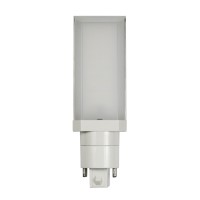CLED Pin-Based LEDs
CLED pin-based LEDs represent the direct LED replacement for compact fluorescent pin-based lamps, offering a straightforward upgrade path from inefficient, short-lived CFLs to modern LED technology. These specialty LED lamps fit fixtures originally designed for 2-pin and 4-pin compact fluorescent bulbs (PL lamps), commonly found in commercial and residential applications including wall sconces, ceiling fixtures, downlights, and task lighting. The pin-based design uses G23, G24, GX23, GX24 and similar bases where the lamp has two or four pins that plug into a socket, rather than a screw base. Converting these fixtures to LED provides immediate energy savings and eliminates the frequent maintenance issues associated with CFL technology.
The challenge with converting pin-based CFL fixtures to LED involves the ballast—the electronic component that regulates current to fluorescent lamps. Most CLED LEDs are designed for ballast bypass operation, meaning you remove or bypass the existing ballast and wire the socket directly to line voltage. This ballast bypass provides the most reliable operation and eliminates the ballast as a potential failure point. The wiring modification is straightforward for anyone comfortable with basic electrical work: turn off power, remove the existing CFL, open the fixture, disconnect ballast wiring, reconnect the socket directly to line voltage (typically two wires), close the fixture, and install the LED lamp. Some CLED LEDs offer plug-and-play ballast-compatible operation, allowing installation without rewiring, though ballast bypass is generally preferred for long-term reliability.
Energy savings with pin-based LED retrofits are significant because many existing CFL fixtures use 13-26 watt compact fluorescent lamps that have been in service for years and have degraded in both efficiency and light output. A typical 13-watt CFL can be replaced with a 5-8 watt LED providing equivalent or better light output—a 40-60% energy reduction. For fixtures with 18-26 watt CFLs, replacement with 9-12 watt LEDs delivers similar savings. Beyond direct energy savings, removing the ballast (in ballast-bypass installations) eliminates ballast power consumption and losses, typically adding another 2-4 watts of savings per fixture. For commercial or multifamily buildings with dozens or hundreds of these fixtures, the aggregate savings are substantial.
The lifespan improvement over CFL technology is dramatic and often the primary motivation for upgrading to CLED LEDs. Compact fluorescent lamps typically last 6,000-12,000 hours in real-world applications (often far less than the rated life due to frequent switching), requiring replacement every 1-3 years in fixtures with moderate daily use. Quality CLED LEDs offer 50,000+ hour lifespans, meaning 15-25+ years of typical use with no maintenance. For property managers, building maintenance staff, and homeowners, this virtually eliminates the ongoing labor and expense of changing bulbs in potentially dozens or hundreds of fixtures. The LED technology also delivers instant-on operation without the annoying warm-up delay of CFLs, and produces no humming or buzzing.
Color temperature options for CLED pin-based LEDs typically include 3000K, 3500K, 4000K, and 5000K, allowing you to match or improve the lighting character of your space. The 3000K warm white works well in residential applications (hallways, bedrooms, living areas) where comfortable, inviting light is desired. The 3500K neutral white offers a balance between warmth and clarity, popular in commercial and hospitality settings. The 4000K cool white provides crisp, energizing illumination suitable for offices, retail spaces, and task-oriented areas. The 5000K daylight option delivers very white, vibrant light preferred for applications requiring excellent color perception and alertness—workspaces, healthcare facilities, and commercial environments.
Installation considerations include verifying your existing lamp's base type (G23, G24d, G24q, GX23, GX24 variants), determining whether it's a 2-pin or 4-pin configuration, and noting the wattage. Pin-based lamps come in several base types that are not interchangeable, so correct identification is essential. Many fixtures have labels inside that specify the compatible lamp type. When performing ballast bypass, ensure you understand the fixture wiring and feel comfortable making the modifications, or hire an electrician. Keep the disconnected ballast in the fixture (secured safely) or remove it entirely—either approach works. Label the fixture to indicate ballast bypass and LED lamp required, helpful information for future maintenance.
The light quality of modern CLED pin-based LEDs equals or exceeds CFL performance. High CRI (Color Rendering Index) ratings of 80-90+ ensure colors appear natural and true, important for retail displays, residential living spaces, and anywhere color perception matters. The uniform light distribution and quality diffusion of well-designed CLED LEDs provide even illumination without the visible LED components or hot spots sometimes seen in cheaper LED retrofits. The instant full-brightness operation, stable light output unaffected by ambient temperature, and flicker-free performance create superior lighting compared to aging CFL technology.
Cost-effectiveness of CLED LED retrofits is compelling when you account for energy savings, maintenance labor elimination, and extended replacement cycles. While the initial cost per lamp ($8-20 depending on wattage and quality) exceeds CFL prices ($4-8), the LED will outlast 5-10+ CFLs while saving substantial energy. For a building with 50 fixtures, converting from 18W CFLs to 9W LEDs (with ballast bypass) saves approximately 11 watts per fixture × 50 fixtures × 10 hours/day × 365 days = 20,000+ kWh annually, worth $2,000-3,000 at typical commercial electricity rates. Add the elimination of maintenance labor for 100-250 CFL changes over the LED lifespan, and the return on investment is often under 18 months.
Common Applications: Commercial and office ceiling fixtures, wall sconces, downlights, task lighting, multifamily residential hallways and common areas, healthcare facilities, retail spaces, anywhere compact fluorescent pin-based lamps are currently in use
Key Advantages: 40-60% energy savings versus CFL, 50,000+ hour lifespan eliminates frequent maintenance, instant-on operation with no warm-up, no humming or buzzing, better light quality, ballast bypass eliminates ballast failures, flicker-free performance
Common Base Types: G23 (2-pin), G24d (2-pin), G24q (4-pin), GX23 (2-pin), GX24 (4-pin). Verify your existing lamp base type before ordering.
LED-PLG24Q-H4K Cool-White 4000K
Wattage: 9W, Type: CLED Pin-Based, Color Temp (Kelvin): 4000K, Lumens: 1000, Replaces: 13-26W CFL..
$14.95
LED-PLG24Q-H35K Soft-White 3500K
Wattage: 9W, Type: CLED Pin-Based, Color Temp (Kelvin): 3500K, Lumens: 1000, Replaces: 13-26W CFL..
$14.95
LED-PLG24Q-H3K Warm-White 3000K
Wattage: 9W, Type: CLED Pin-Based, Color Temp (Kelvin): 3000K, Lumens: 1000, Replaces: 13-26W CFL..
$14.95
LED-PLG24Q-H27K Warm-White 2700K
Wattage: 9W, Type: CLED Pin-Based, Color Temp (Kelvin): 2700K, Lumens: 1000, Replaces: 13-26W CFL..
$14.95

